In Times of Conflict, How Can We Support the People Who Keep Culture Alive?
A Smithsonian research fellow weighs in on the ways culture proves both vital and resilient
/https://tf-cmsv2-smithsonianmag-media.s3.amazonaws.com/filer/35/1e/351e8692-f3b6-4031-b956-85d67d7dc4cd/photo-3-sff2018_06-29_hn_0086.jpg)
The fate of Armenian cultural heritage sites in Nagorno-Karabakh is unknown. A recent Smithsonian magazine article highlighted why scholars and cultural institutions are calling to protect Armenian heritage in the landlocked mountainous region in the South Caucasus.
The report succinctly described the situation leading into the current conflict.
Legally recognized by the international community as part of Azerbaijan, Nagorno-Karabakh has been controlled by an ethnic Armenian majority since 1994, when the clashing nations agreed to a ceasefire. Following the war’s conclusion, the region’s Armenian residents established a “separatist, self-declared [but unrecognized] republic … backed by the Armenian government,” per BBC News. The countries have been locked in a tense stalemate punctuated by occasional violence, such as a period of fighting in early April 2016, according to the Council on Foreign Relations.
While a Russian brokered peace deal remains precarious, the status of Armenian heritage sites on lands that have been ceded to Azerbaijan is a growing concern. Not only have those from Azerbaijan, known as Azeris, launched intentional attacks on heritage sites, like the Holy Savior Ghazanchetsots Cathedral, they have also intensified a campaign to assert alternative historical narratives for the heritage in the region. Heritage once again finds itself at the crosshairs of conflict.
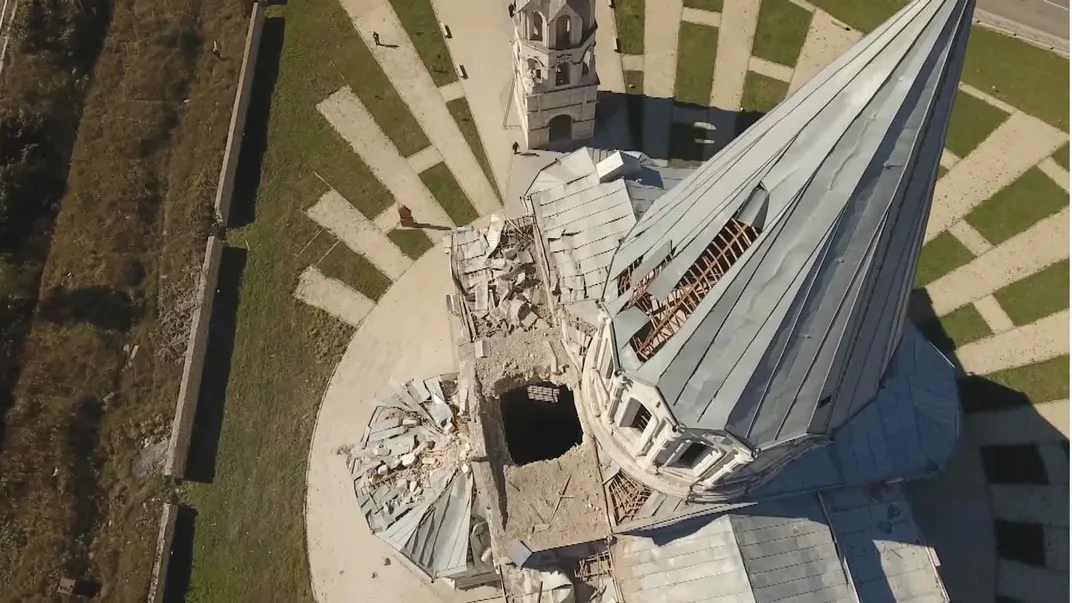
“Azeri aggression against the rich and irreplaceable cultural heritage of its indigenous Armenian people has only just begun,” wrote Christina Maranci, professor of Armenian art and architecture at Tufts University.
These sites, despite being historic locales, are integrally tied into present realities. They are spaces where people create and affirm their identities, meet with friends and family, or even make their livings, whether acting as priests at a small medieval church or setting up locally run B&Bs to cater to tourists. Many heritage sites are not inert buildings that are purely vessels of history but are also living and breathing entities that are very much situated in the daily lives of those that live around them.
Take for example the Associated Press' haunting photos of the situation, including a couple getting married in Ghazanchetsots Cathedral surrounded by rubble and debris. Just days before the 19th-century cathedral had been relentlessly shelled by Azeri military forces. Targeting heritage sites, whether through physical destruction or historical revisionism, is a powerful tool in the arsenal of modern warfare. Examples of heritage in conflict abound, ranging from ISIS’s staged demolition of Palmyra in Syria to the destruction of the Old Bridge of Mostar (Stari Most) during ethnic conflict in Bosnia and Herzegovina in the 1990s.
Following the conflict in Nagorno-Karabakh, media outlets, cultural institutes, dignitaries and scholars, including the Metropolitan Museum of Art, the New York Times, Russian Foreign Minister Sergey Lavrov and UNESCO general director Audrey Azoulay released statements denouncing the destruction of sites and calling for documentation, monitoring and preservation of the region’s cultural heritage. While these appeals for safeguarding and monitoring heritage are necessary, they often view cultural heritage as immobile, tangible spaces without taking into account the living, intangible qualities of heritage—music, dance, song, cooking, craft and storytelling, to name a few.
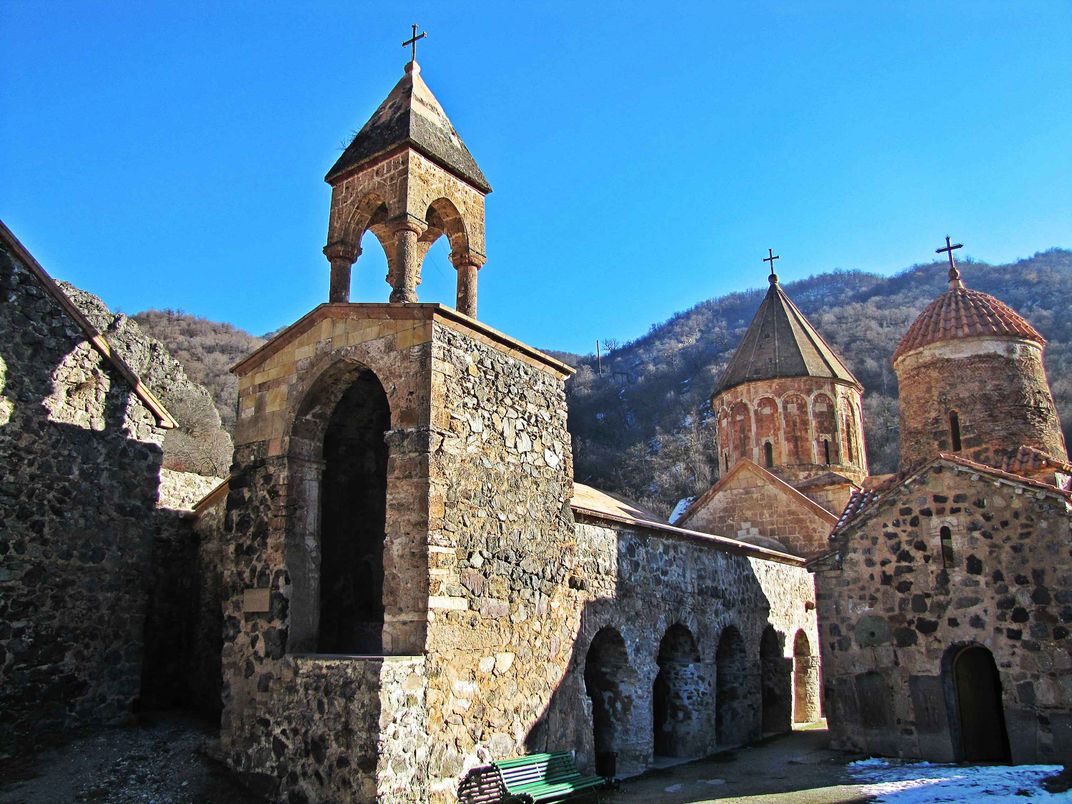
Calls to action, which denounce the physical destruction of sites, should also spotlight the threat heritage decimation has on people and their cultural livelihoods. The trope of a universal, common heritage that must be saved for future generations is heralded and helps to stir international attention and assistance, but we must equally take into consideration a need to support the people who have a hand in keeping their culture alive and thriving. In addition to contributing humanitarian aid, we should be supporting and creating spaces that allow cultural ingenuity and heritage expression to flourish. While not a perfect solution, this action would give agency back to those who have experienced attacks on their history, heritage and identity.
In times of struggle, supporting a peoples’ collective creative output helps to generate hope and resiliency. In the summer of 2018, the Smithsonian Folklife Festival showcased two international regions in the programs—“Catalonia: Tradition and Creativity from the Mediterranean” and “Armenia: Creating Home” on the National Mall in Washington, D.C. While the Festivals are planned and organized years in advance, that summer happened to mark a period of political turmoil and unrest for both Catalonia and Armenia.
In October 2017, the semi-autonomous region of Catalonia had voted for independence, a move declared illegal by Spain’s Constitutional Court, which led to the Spanish government dissolving the Catalonian parliament and ordering immediate regional elections. Just weeks before the Folklife Festival, Catalan nationalists in June regained control of the region, ending Madrid’s direct rule.
As tensions flared in Catalonia, Armenians were experiencing similar social unrest, with the April-May 2018 Velvet Revolution, where civilian protesters won against the deep-rooted corruption and oligarchical nepotism that had infiltrated Armenia’s post-Soviet government. Yet in the midst of all this political upheaval, more than 100 participants flew from Armenia and several hundred from Catalonia to share their culture, heritage, and hopes for the future with the hundreds of thousands of tourists who descended upon the National Mall to enjoy the Folklife Festival activities.
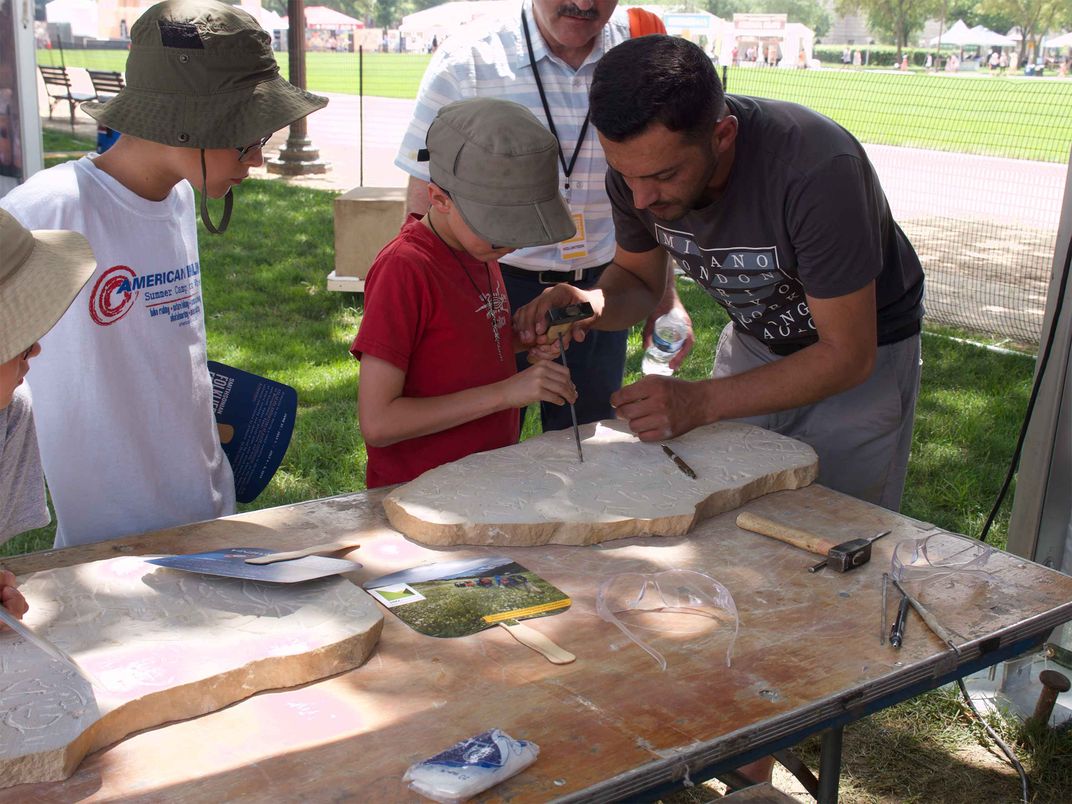
The synergy between the two groups and their love for their craft and heritage was palpable. As a presenter at “Armenia: Creating Home” and an ethnographer conducting field research, I spent a great deal of time with the participants from both Armenia and Catalonia and witnessed a heartfelt enthusiasm as they shared their songs, stories, crafts and food with each other and with visitors. The Armenian participants were familiar with the Catalonian struggle, both through their recent Velvet Revolution, but also in their ongoing plight with Azerbaijan over Nagorno-Karabakh.
There was a language barrier between Armenians and Catalonians, but they found unique ways to communicate. Joint programming often fostered this communication, like when Catalan baker Angel Zamora and Syrian Armenian chef Andranig Kilislyan cooked together on the Hatstatoun (Armenian for “bread house”) stage to prepare coca de recapate and lahmajun, Catalonian and Armenian snacks centered around a favored ingredient: bread. But there were also moments of impromptu heritage connections, like how Catalonian and Armenian presenters would burst into song and dance in the hotel after Festival work hours, often playing improvisational music that seamlessly and surprisingly wove together the heritage sounds of both regions.
On the last evening of the Festival, after the crowds had all gone home, several Armenian participants and food vendors beckoned their Catalonian counterparts over to their performance tents and stages set up on the Festival grounds. Armenian BBQ was passed around, wine flowed and the Armenian musicians played traditional dance music.
There, in the shadow of the Washington Monument, we danced in a shared expression of communal euphoria in a closing-night celebration of the two-week summer Festival. It was a demonstration on a large scale of how heritage practices—singing, dancing, and the sharing of food brings people together. One Armenian participant noted of her new Catalonian friendships, “I never thought I would find a group louder and more boisterous than Armenians, but I think we’ve met our match!”
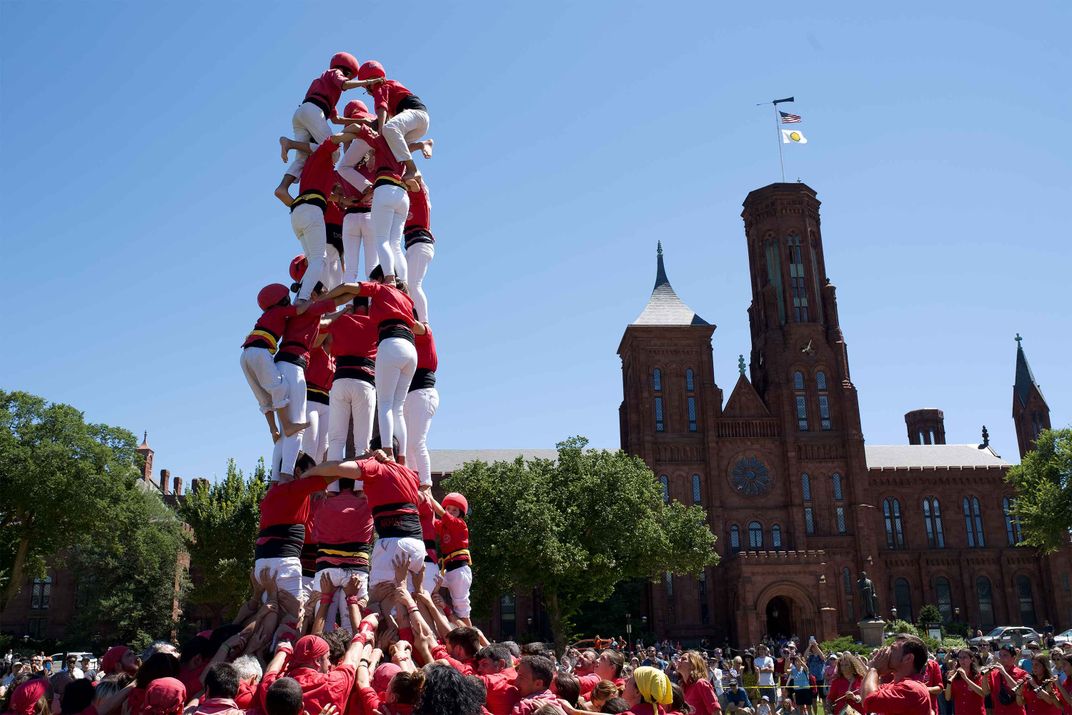
While the evening was celebratory, it also reified a deeper bond: a connection both groups felt through their shared socio-political struggles. As one Armenian American reflected about Catalonia’s presence at the Festival and the simultaneous conflicts happening in both regions, she recalled, “I viscerally understood, to be this country [Catalonia] surrounded by adversaries and in danger and to fight for freedom is something we [Armenians] knew very well.”
Unfortunately for Armenians, that fight has now escalated into a war. On September 27 this year, Azerbaijan, backed by the Turkish government, launched an offensive on Nagorno-Karabakh as a means to take over the regain. Thousands of Armenian soldiers were called to the front lines to protect and defend Nagorno-Karabakh.
Ruben Ghazarayan, a participant at the 2018 Folklife Festival, was one of the thousands of Armenians that served on the frontlines. Ghazarayan along with his brother Karen, are self-taught stonemasons from Yeghegnadzor and constitute some of the only artisans who continue to practice khachkar (cross-stone) making in Armenia. I remember their joy and enthusiasm at the Festival as they interacted with visitors who asked countless questions about their craft, even letting some curious onlookers take a hand at carving. Visitors were fascinated with the Ghazarayans’ limestone khachkars and their masterpieces sold out in the Festival Marketplace; the first time their work was ever offered for sale outside of Armenia.
They left excited for the growing possibilities and admiration for their craftsmanship, and when I visited them a year ago in Armenia they were overjoyed to show me their newly renovated workshop at the base of the Areni-1 archaeological cave complex; a harmonious example of how heritage sites, cultural production and living go hand-in-hand.
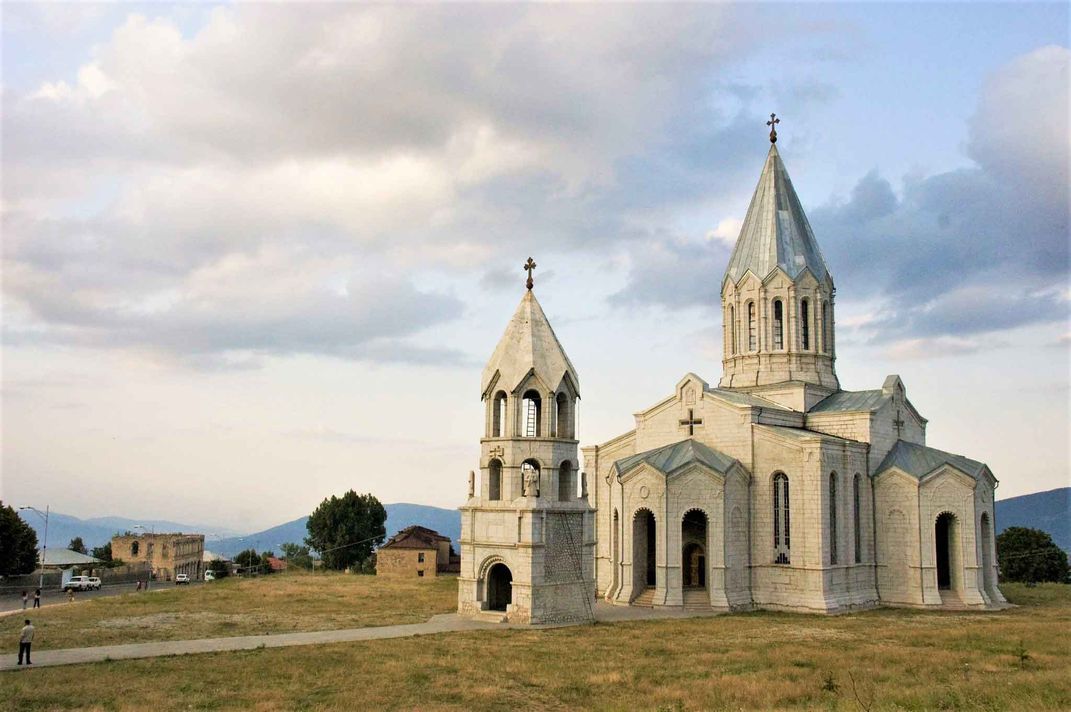
This past October, as Ruben Ghazarayan fought on the frontlines of the Nagorno-Karabakh conflict, his brother Karen turned to making and selling their khachkars to Armenian diaspora abroad to support their families during the conflict. Despite the uncertainness of war, Karen took to his hammer and chisel to produce cultural heritage as a means of sustenance and resilience because as he says: “In these hard times, khachkars are our places of worship (church).”
Karen continues to work, despite not having his brother by his side, because as he says: “Now more than ever it is important to talk about Armenian arts and Armenian culture. Our khachkars are a small wish and hope for our diaspora, our friends, and our relatives abroad.” While conflict still broils in the region and the fate of Armenian heritage sites in Nagorno-Karabakh remains in a precarious state, Armenians continue to produce and sustain cultural practices despite direct attempts to erase their heritage.
/https://tf-cmsv2-smithsonianmag-media.s3.amazonaws.com/accounts/headshot/Papazian_Headshot.jpg)
/https://tf-cmsv2-smithsonianmag-media.s3.amazonaws.com/accounts/headshot/Papazian_Headshot.jpg)